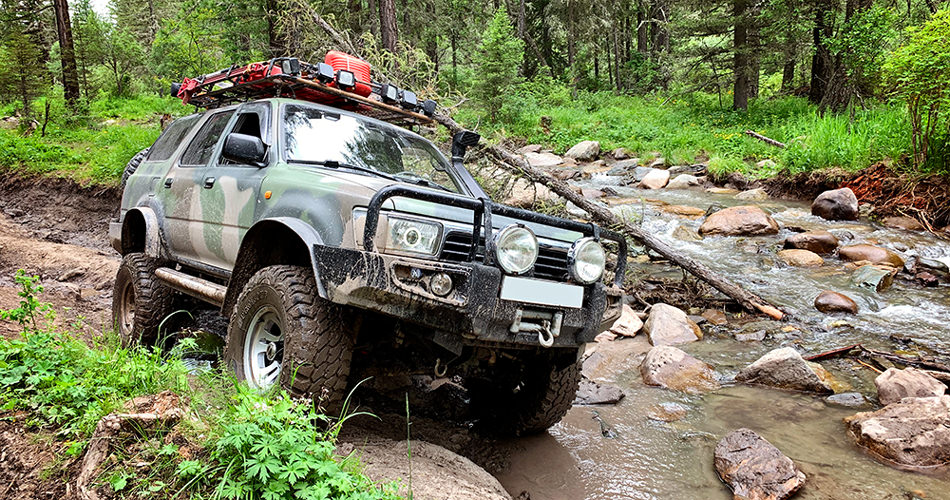
While no special license is needed for off-roading, there are many practices and techniques that go with navigating the countryside on four wheels. Unfortunately, the availability of 4x4s, whether in the form of traditional trucks or trail-worthy SUVs, has sped up the four-wheeling initiation, so many tips and tricks that were taught through involvement and camaraderie are getting skipped. If you’ve recently bought your first real 4×4 and are ready for some trail-dusting, this is what you should know.
Know your limits
The best way to destroy your truck is to overestimate the trail, your vehicle, and your skill. Tackling any serious terrain with a small engine and 4-speed automatic transmission is out of the question. You should be aware of your ground clearance, as trying to engage tall terrain features with a low-riding (by 4×4 standards) base you risk cracking open your oil pan, gearbox, and differentials. These are all serious issues that can get you stuck in the middle of nowhere. The bottom line is, if you want to tackle tough terrain, you need a tough truck.
Maintain your gearbox
The automatic gearbox isn’t the best option for an off-roading vehicle, as it can overheat more easily. Repeated overheating causes the gearbox fluid to lose its properties. Manual gearboxes, on the other hand, use heavier lubricants that don’t overheat so easily. In both cases, you need to change the fluid regularly, while with an automatic, change the filter as well. Drain the fluid through a filter paper to see if there are any metal shavings. A small amount is fine, but large pieces or large amounts of shavings might be a sign that breakdown is near.
Set your tyres right
When driving on gravel and sand, reduce tyre pressure for increased traction. For off-roading in general, your tyre pressure should be within 18 to 20psi. This is different from highway requirements that typically go between 28 and 35psi. Always read the manufacturer’s label on the inside of the driver’s door. It goes without saying that any serious trail driving requires quality all-terrain off road tyres. Their durability and traction in different conditions come from years of research in motorsports off-road racing. Online vendors typically grade these tyres by the handling, comfort, durability, and fuel economy, so you can easily compare different products and choose the best one for your needs.
Avoid rollovers
When driving downhill or steep terrain, always drive straight, as diagonal descent can get you rolling over in no time. Heavier trucks will usually slide sideways before rolling over, so if the slide sets you off the track, stop immediately. If you feel you’ll roll over, turn the vehicle into the slide and drive it down. If that’s impossible, turn off the engine, hold down to your seat firmly, and hope that seat belts will do their job.
Cross obstacles at an angle
Whenever you need to cross a ditch or a log, do it with one wheel at a time, while the remaining three help it climb over. In some cases, your truck can pitch, with one or more wheels catching air. Be careful in these situations as logs can bounce up and hit the undercarriage so tackle these obstacles slowly. The worst thing that can happen to you is to get one of the front wheels and one of the rear wheels in the ditch at the same time.
Ford carefully
Off-road beach trails often have tidal run-out creeks that you may want to ford. While they may seem shallow, any body of water can be deceptive. Even if you estimate the depth, you never know if there are any deep holes along the base. If possible, walk the stream first and mark any risky areas. A water crossing is no game, and unless you estimate the drop, you can easily jam your bullbar one foot into the sandy bank, with saltwater washing over your engine bay.
Raise the sand flag
In dune driving, your visibility, as well as the visibility of a fellow off-roader, is severely limited, so you should fit a sand flag. Basically, it’s an orange flag fitted to a flexible pole that is attached to your bullbar. You can easily make one yourself, but your nearest 4×4 store should have them in stock. Even if the vehicle approaching you from behind the dune doesn’t have one, at least they should know you’re coming through.
Generations of old-school off-road enthusiasts have developed unspoken trail-etiquette that not only helps everyone get along on the trail but also return safely. This quick guide points to some of the rig requirements, but also the essential off-road driving techniques.




